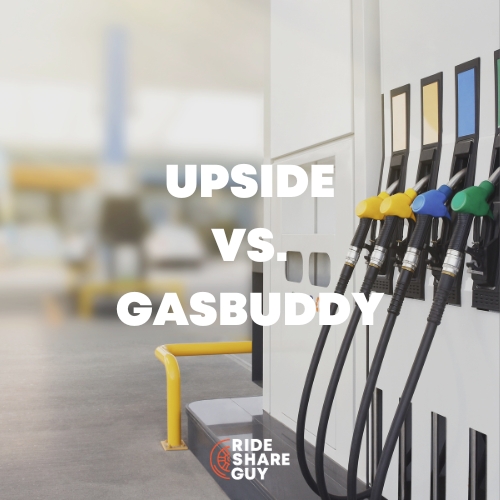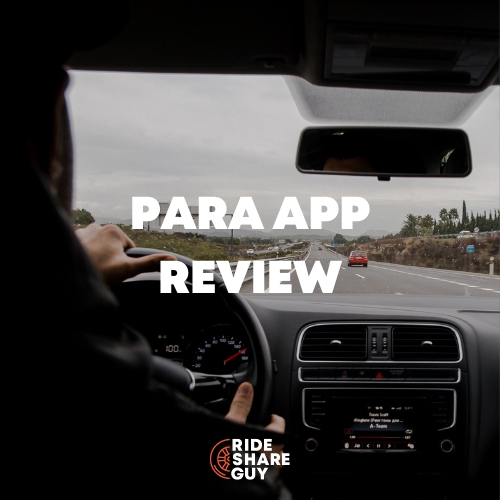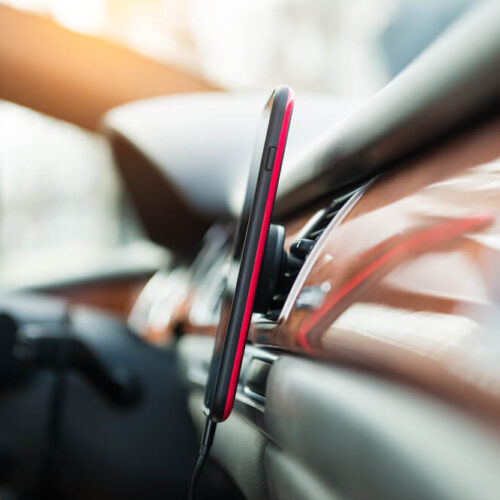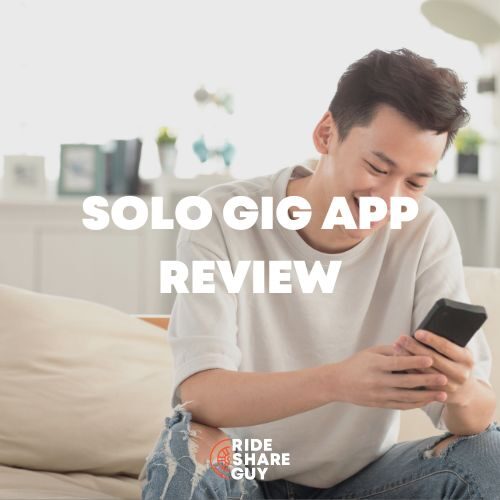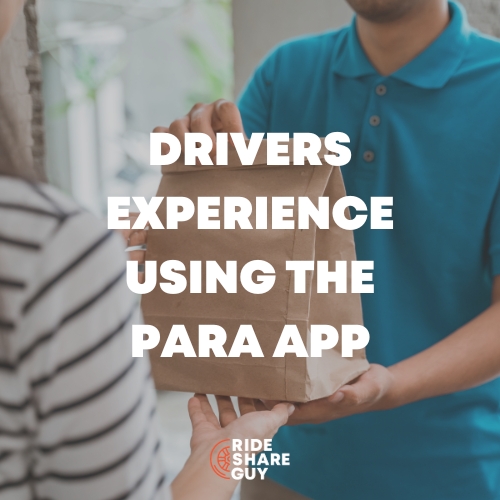There’s a new rideshare company in town, but can it challenge Uber and Lyft? Senior RSG contributor Will Preston covers Bounce, a rideshare service in San Diego, CA with a very different pay out model than Uber and Lyft. Will it work? Let us know your thoughts in the comments below!
Bounce is a new rideshare company that offers a very different compensation model than what you typically see in the rideshare market. At this time, it’s only available in San Diego, but they have dreams of expansion. Drivers are directly compensated based on how much they drive, how long they’ve been driving for the company, and how much they help promote the company.
In addition, drivers are given stock options in the company with a 25-month vesting schedule. The company also offers some unique features for riders that give Bounce drivers a reason to recommend it to their Uber and Lyft passengers.
Bounce is currently only available in San Diego, but you can learn more about it and see when they are expanding to your area here.
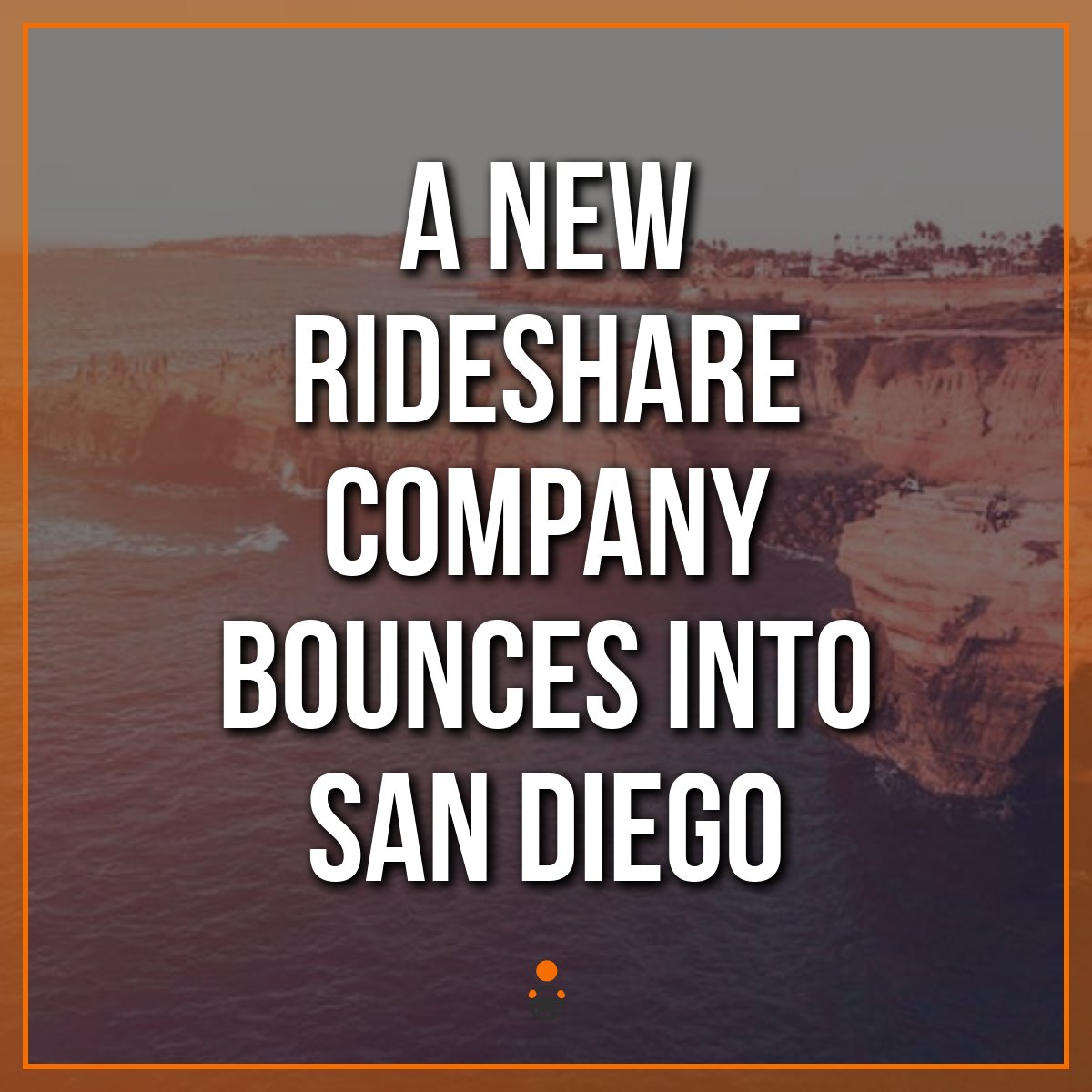
The Basics of Bounce
Bounce is a two-year-old rideshare company founded by Mark Potter, who successfully litigated civil and employee rights for over twenty years. Given that many drivers feel that Uber and Lyft take advantage of driver’s rights, having a rideshare company founded by someone who has defended such rights is an interesting idea, indeed. Externally, Bounce appears to be like any other rideshare company, but it’s very different.
How is Bounce Different from Traditional Rideshare Companies?
The first difference is that Bounce gives the driver one major piece of information that none of the other rideshare companies seem to give, although Uber is apparently experimenting with it: the distance the passenger intends to go after you pick them up. Note in the image below it tells the driver the passenger wants to go 121 miles. Bounce does not yet support destination filters, but this is definitely a step in the right direction.
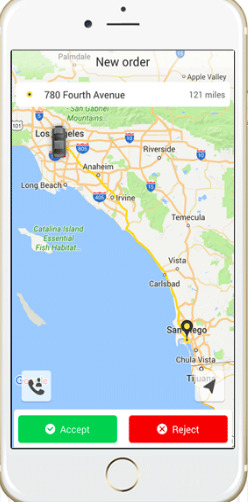
Another difference happens on the rider side. If a rider gets a ride with a driver they like, they can add that driver to their list of “favorite drivers.” If they then issue a regular ride request, Bounce will do its best to offer their ride to any of their favorite drivers that are currently online. A rider can even directly request their favorite driver.
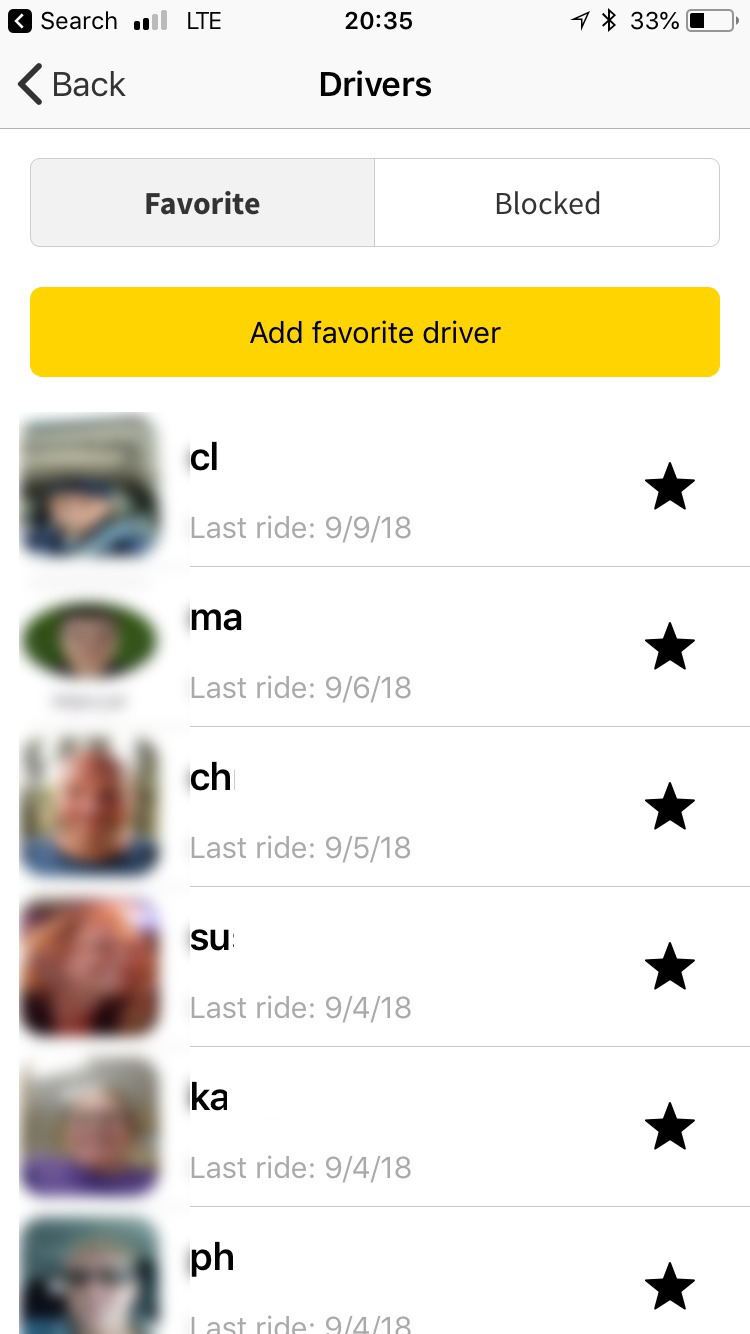
How Much are Fares with Bounce?
At this time, passenger fares are just under the rates that Uber and Lyft are currently using in San Diego. Bounce charges $1.15 per mile versus $1.16 for Uber. (They both charge $.15/min.) There is also a $2.24 booking fee, compared to Uber’s booking fee of $2.85. Unlike Uber and Lyft, however, Bounce does not calculate an “upfront price,” choosing instead to give the passenger a price estimate. The passenger’s actual price is calculated based on actual time and distance traveled – just like Uber and Lyft used to do. This avoids the upfront price rip off that I covered in this article.
Uber vs. Lyft vs. Bounce Pricing in San Diego
| Uber | Lyft | Bounce | |
| Per mile | $1.16 | 1.16 | $1.15 |
| Per minute | $.15 | $.15 | $.15 |
| Service fee | $2.85 | $2.65 | $2.24 |
In addition, Bounce does not use anything like surge pricing. It seems that they believe the price should be the price, whatever that is. While some drivers may immediately lose interest when they hear there are no surge fees, it’s important to consider Bounce’s overall comp plan before making a decision.
A slightly lower per mile fee, lower booking fee, no “upfront” inflation, and no surge pricing allows Bounce drivers to tell their Uber and Lyft passengers that Bounce will always be less expensive than Uber or Lyft. Drivers can also tell their passengers that Bounce also pays their drivers better. Add to that the idea of favorite drivers, and every passenger I have spoken to thinks the idea of Bounce sounds great.
Bounce Driver Compensation
A new Bounce driver is paid the way Uber and Lyft drivers used to get paid: 75% of what the passenger pays minus the booking fee, with a minimum fee of $4. That is where the similarity stops. There are actually several ways make money with Bounce.
First, drivers can increase their percentage from 75% to 80% based on seniority or recruiting other drivers. For each 100 rides given by you or drivers you refer, your base fair compensation goes up by 1%, up to a maximum of 80%.
Lifetime royalties for directly referred drivers and riders
Drivers earn a 1% royalty on all rides given by directly referred drivers and passengers. (A directly-referred driver or passenger is one that signs up with your driver code.) The initial royalty is smaller than the fees that Uber and Lyft give to sign up a new driver, but it’s important to understand that this fee is paid forever, even if you’re no longer driving for Bounce.
In fact, Bounce has non-driving partners that only make money by referring drivers and passengers. Note also this commission paid for drivers and riders, and Uber and Lyft have no similar fee for referring riders.
Acquisition bonuses on drivers and riders that deliver or use the service
This one’s a little detailed, but suffice it to say that it gives you more incentive to sign up new people that actually use or deliver the service. (As discussed later in the article, please note you get nothing if your new “drivers” don’t actually drive, or your new “riders” don’t actually ride.) Each time you sign up a driver that actually starts driving, or a customer that actually starts using the service, you earn points towards a $100 bonus. It takes 3 drivers giving three rides each and 3 riders taking one ride each to qualify for the bonus, and the points never expire.
Royalties for indirectly referred drivers and riders
Active drivers are also paid royalties on indirectly referred drivers and riders, which is a driver or rider is one that signs up using a referral code of someone you signed up, or of someone they signed up, etc. I’m reminded of theHeather Locklear Faberge’ commercial from the 80s, “I told two friends, and they told two friends, and so on.”
These additional royalties require partners to be “Active” on Bounce, which requires to you generate at least 100 activity points in a calendar month. The following slide from the Bounce compensation plan explains the various ways to earn points.
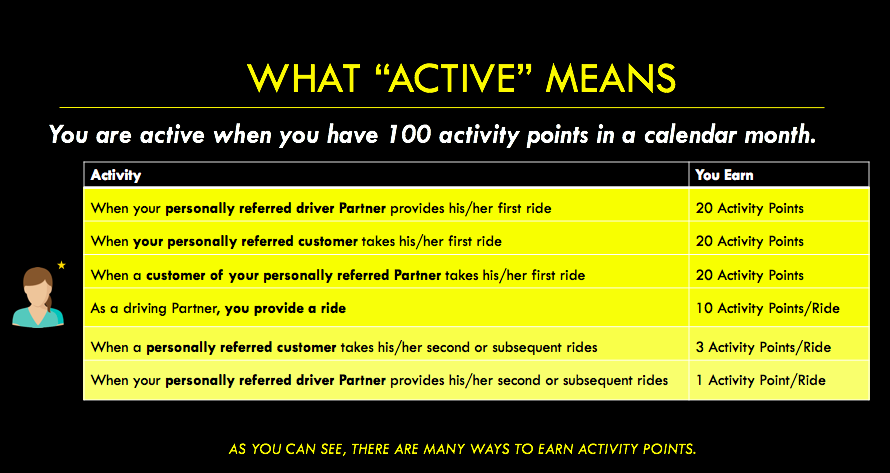
Multiple drivers I have spoken to told me that it’s pretty easy to maintain Active status. They told me 10 rides a month or five new referrals, or some combination thereof, is pretty easy to accomplish.
Royalties on indirectly referred drivers and riders
Additional levels of compensation are based on the activity of you and what Bounce refers to as your network. Your network consists of:
- Directly referred drivers
- Directly referred passengers
- Drivers referred by drivers you referred (up to five levels deep)
- Passengers directly referred by those drivers
For example, you refer Steve as a driver, who refers Jessie as a driver, who refers Michael as a driver, who refers Richard as a driver, who refers Susan as a driver, which is five levels of drivers. You, Steve, Jessie, Michael, Richard, and Susan also directly preferred passengers with their driver codes, which is five levels of passengers. Your network consists of all those drivers and riders. Steve would be on level 1 of your network, Jimmy would be on level 2, Michael on 3, and so on. Passengers directly referred by you are on level 1, passengers referred by Steve are on level 2, and so on.
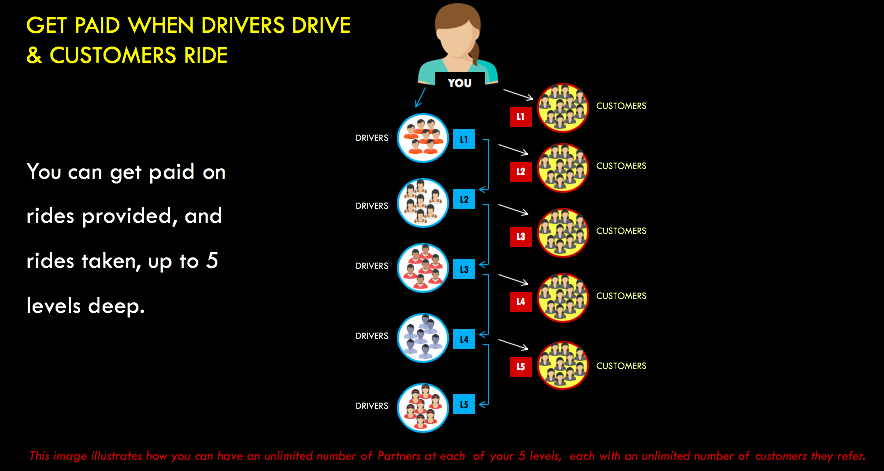
These royalties are based on levels of participation, from Bronze to Diamond, each with its own payments and qualifications, based on a combination of being Active (as defined above), and a certain level of activity by your partner network.
A Bronze partner must be Active, and their network needs to have grown to the point that drivers in their network have given 100 rides, or riders in their network have taken 30 rides. (This latter requirement is a lifetime requirement, not a monthly requirement.)
If you are a bronze partner, you receive base fare royalties on up to three levels of drivers and passengers. You receive 1% of levels 1 and 2, and .25% of level 3. Without going into the details of each level, the highest level (called Diamond), pays a royalty of 1% on Levels 1 and 2, and .5% royalties on levels 3-5.
Other bonuses
There are two bonuses that are paid each month to certain drivers: the “every 20 new customers” bonus, and the “101st ride” bonus. Every month, .5% of the company’s base fare revenue is put in each bonus pool.
Every time you sign up 20 more customers, you earn one “share” in the “20 new customers” pool for that month. (If you signed up 60 new customers in a month, you’d have three shares in.) Every time you or one of your directly referred drivers gives your 101st ride, you’ll get a share in the “101st ride” pool for that month. At the end of the month, the pool is divided up and paid out to qualified drivers, based on how many shares they have in the pool.
Stock Options
Bounce drivers are given 1000 stock options when they sign up, and more at various milestones, each batch with its own 25-month vesting schedule. Every month you are Active (as defined above), you vest 4% (1/25th) of your options. If you are not Active in a given month, the options that would have vested in that month are forfeited.
Bounce FAQs
Can you get in trouble for recruiting for Bounce?
I wondered if you could get in trouble talking about Bounce to Uber or Lyft passengers. While this used to be a problem in the past, it was apparently not enforceable due to our independent contractor status. Uber and Lyft might not be happy about it, but there’s also not much they can do about it.
Isn’t this a pyramid scheme?
My layperson’s interpretation of the FTC guidelines on pyramid schemes suggests that they do not fit the classic definition of a pyramid scheme. Here’s a great excerpt from that document.
“Multilevel marketing programs are known as MLM’s, and unlike pyramid or Ponzi schemes, MLM’s have a real product to sell. More importantly, MLM’s actually sell their product to members of the general public, without requiring these consumers to pay anything extra or to join the MLM system. MLM’s may pay commissions to a long string of distributors, but these commission are paid for real retail sales, not for new recruits.”
A real MLM program sells an actual product/service to the general public, which is exactly what Bounce does. Second, commissions are paid for sales, not for recruiting. Note that although you have to recruit to get commissions with Bounce, you do not get any commissions until your recruited drivers actually “sell” a ride to someone, or one of your customers “buys” a ride.
Another cause for concern is if a significant percentage of the purchase price goes to paying commissions. The max percentage that would go to all participants in Bounce is 3.5%. That’s three levels of .5% and two levels of 1%. The bulk of the rate (up to 80%) still goes to the person delivering the service. This means that, unlike most MLMs, the person “on the bottom” actually makes most of the money, and the products are actually less expensive than competitors.
Another frequent issue with most MLM programs is you have to achieve a certain level of achievement – and maintain that level – in order to be compensated. While there are levels of compensation that do require a certain participation, it’s important to note that the first level of compensation beyond fares is 1% of all drivers and riders you recruit. That is paid forever and does not require you to be active in the program. I think that’s significant.
Will Bounce be successful?
Drivers (and readers of this site) love to hate Uber and Lyft, and love to talk about low pay. You should see how Bounce drivers talk about it. They love driving for Bounce, and they look forward to a day when they no longer have to drive for Uber or Lyft. Some of them even look forward to a day when they don’t have to drive for Bounce, and only need to continue recruiting. That would require a lot of recruiting, but it could be possible given the right conditions.
In the coming months, I’m going to deepen my evaluation of Bounce by joining as a driver and using it as a rider. Watch for more information as the story unfolds. If you’re interested in signing up as a driver or rider, my driver referral code is Curtis20.
Readers, have you heard of Bounce before? If not, what do you think of it?
-Will @ RSG
